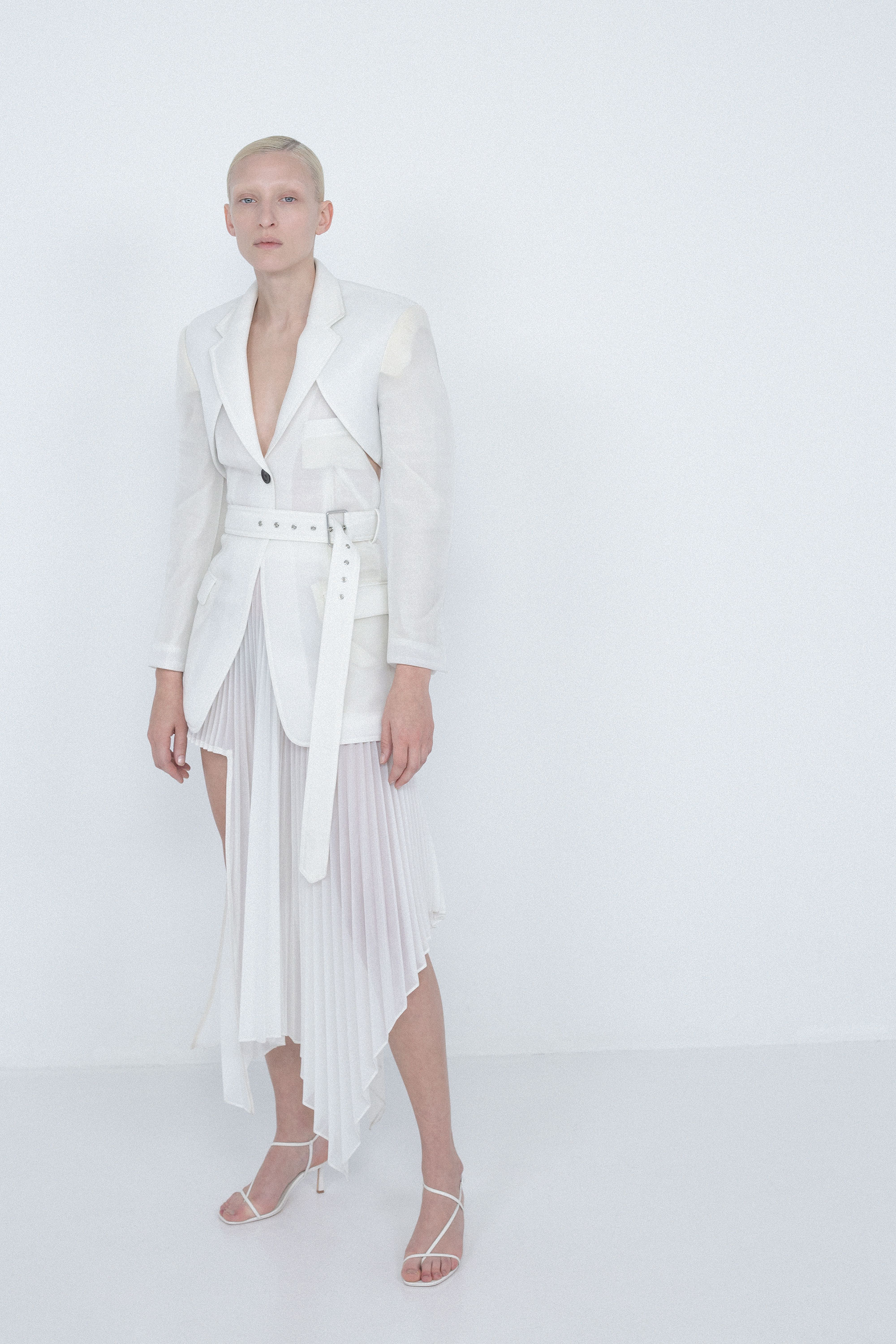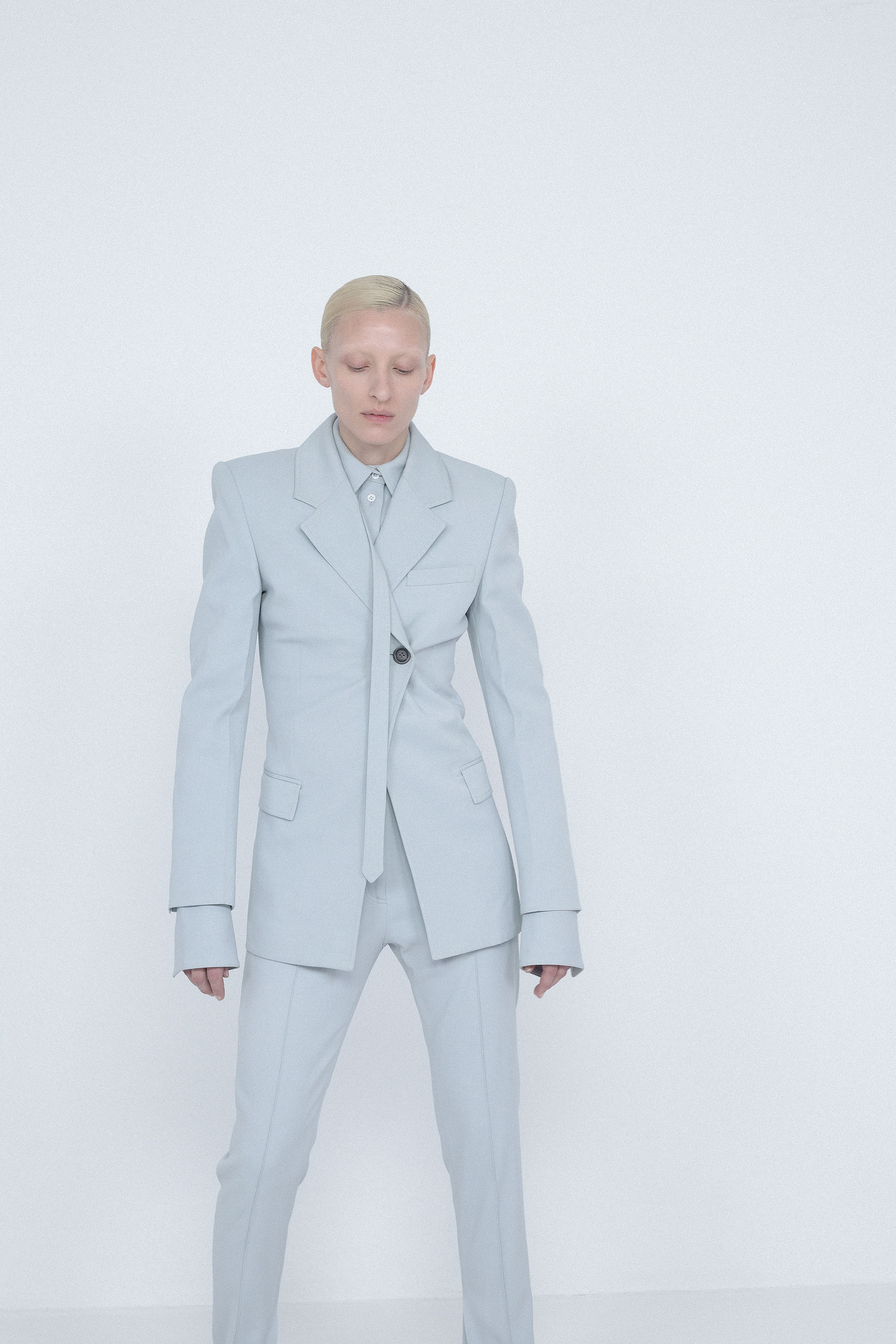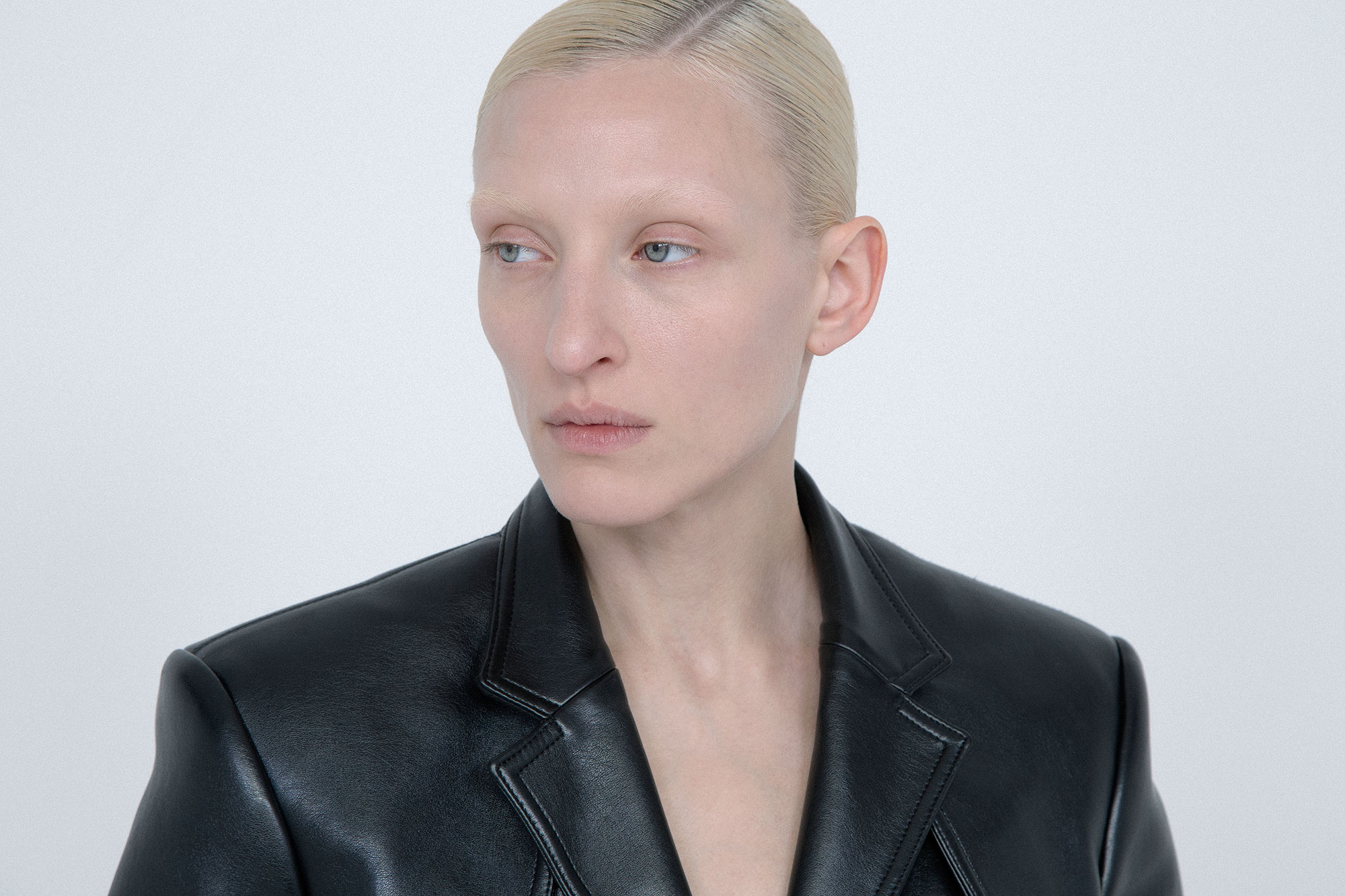
It’s not easy being a new designer in the current fashion landscape. With acclaimed retail spaces that once championed talents to know, crumbling under the weight of rising rents and digital competitors like Opening Ceremony and Barneys, new labels will have to navigate uncharted waters and compete with decades-old heritage brands. Peter Do has risen amongst the new vanguard of emerging talents in New York, presenting a luxurious point-of-view that pairs easily with the downtown New York woman – effortless tailoring with convertible elements and supple fabrics to match. A student from the School of Phoebe, he’s worked at Celine and Derek Lam while calling Helmut Lang and Martin Margiela his icons, the latter a suitable fit as he chooses to go against the Millenial grain and design in anonymity. With visuals shot by Pablo Ravazzani for Models.com, we spoke to Do and business partner Vincent Ho about how he started his business in 2018, why he currently chooses to forgo a runway show and what’s next on the horizon.
Photography – Pablo Ravazzani for Models.com
Stylist – Sho Ishikura | Sittings Editor – Irene Ojo-Felix
Hair – Tetsuya Yamakata | Makeup – Mariko Arai
Model – Maggie Maurer
I wanted to go back to the beginning where you got your start, and how you eventually evolved to come back to New York and start a line here.
Peter Do – New York feels like home to me. When I lived in Europe, I wasn’t as inspired as when I lived here. It’s different because the way I work is more in sync with New York City. You can be who you are and people accept you. Whereas Paris still has a lot of layers, politically. It’s a lot harder to get into fashion’s inner circle. There are so many rules and laws and I was just very unhappy living in Europe. I don’t feel inspired when I’m not happy.
It’s a great time to be a designer right now, but there are also so many changes that have happened; especially within the retail space. I noticed that primarily if it’s not on your site, you guys focus on wholesale with just a couple of stores. How has the process been having a brand in New York, while adapting to this new changing landscape?
Peter Do – Retail in New York especially is changing very dramatically. A lot of the big establishments are struggling or closing. It used to be an institution. It was a thing to be in Barneys when you were a young brand. Of course, that’s changing. There’s a lot more direct to consumer brands. New York has more of an entrepreneurial spirit. I can do it at my own pace and we are part of the new voices of New York.We don’t have to go through all of these fashion establishments like before to validate our success. We made collections that we carried to Paris. We opened a showroom in a friend’s apartment. We had no appointments and just made it happen.
Vincent Ho – It was really a labor of love, and it’s kind of that New York story of coming to America because Peter is an immigrant. He moved here when he was 14. All five of us were packing a 110-piece collection, going to Paris, setting up in a living room and hoping that people came by. Ironically, that very first appointment we had was Barneys because I was friends with one of the buyers there at the time. After we closed and we were reviewing all our prospects our first season, we had to figure out where we stood in that retail landscape, and how we wanted to sell our products. It’s about being in the right stores, it’s about having partners that can actually pay you to support the brand’s production.
I’m curious about the process of following through with orders once secured.
Vincent Ho – Everything that first year, we were still learning. Every season is a learning experience. There are just so many things that come up that no one can teach you. There are no books you can read about international import taxes. Logistics rules and Russian laws. Deposit minimums. In the two years that we’ve been doing this, I’ve learned so much more in business, retail strategy, distribution and running.
I could ask the question about what’s your normal day to day, but obviously your day to day is ever-changing. How has your day to day evolved recently? How has it picked up?
Vincent Ho – The five of us who started the company were friends who met on the internet 10 years ago. It’s nice to hang out with your friends every day but on the other hand, it’s been a really big learning experience for all of us to navigate where friendship and your professional relationships start to divide. We all really had to step into the roles now that we have people underneath us. I think that because we’re all growing at the same pace, it’s nice to know that we are accepting more responsibilities – it’s a lot more Excel, it’s a lot more emailing.

Taking it back to the design, tailoring and asymmetrical hems are prominent throughout. When did you first develop that point of view and what made you design for this type of woman in New York City?
Peter Do – When I went to school, my main focus was tailoring. I was in womenswear and sportswear but I was doing a lot of men’s construction. A lot of people on our team are men and mostly wear women’s clothes, but we noticed that there’s a lot of things that are not the same. The fabrics are flimsier, the fit is a little bit off, there are no pockets there. There’s a lot of things that don’t make sense. We wanted to bring this idea of tailoring for women but made the same way that people make men’s clothes.
We looked at how men shop; they shop once a year or someone has to go out and shop for them. Their clothes actually last. Whereas I feel like with woman’s clothes, since it’s so trendy people don’t really wear the clothes to the full extent. They would never know whether their clothes are made really well or not. Now you buy an expensive garment and maybe you wear it five times and it falls apart or you never wear it again. I think the idea of bringing back craft and quality for womenswear is the main thing that drives a lot of our fabric choices and the silhouette.
On your site, you have a particular list of retailers that stock your clothes. When you don’t have a traditional runway show or presentation how do you spread the gospel of Peter Do to the masses?
Peter Do – I think there are many parts of this formula because first of all, we are still a startup. For me, there are just more important things that I got to focus on. I want to invest in the quality of our clothes. I want to invest in our factories. Paying them more than other people pay them; cutting shortcuts. I don’t want to have 10 unpaid interns running around the studio. I don’t want them to work on the weekends. Quality of life is important for me and I just don’t see, in that budget plan, having a budget to do anything else. There are all these young brands and they have these big shows, and then have 10 interns, and they’re always looking to fund a collection and they can’t hide anymore.
Vincent Ho – We are very conscious of the funds that we have, as every startup should be. In a fitting sometimes people will ask, well why do you always show in Paris? We knew that that was the one market that all the buyers from around the world hit. Not everyone goes to New York. When we launched in Paris, we did it during pre-collection because we knew that buyers also had bigger budgets. It was easier for them to take on a new brand. I used to work in PR a long time ago, and if you spend all this money on a show and you don’t have the right people there, then what’s the point? We’re young and we’re scrappy, but I knew that there was no way six months into launching a brand that we would get people into that space. So why not allocate those funds? Even if it’s the fact that people are happier to go to work – that’s enough of a return for us.
What’s the most challenging thing that you would want to design next?
Peter Do – Every season we try to solve something that we think is a problem. Whether it is wardrobe malfunctions or launching new categories. Every time we do that, it comes with a new set of issues. It’s exciting to have these problems though. I’m being challenged and stimulated. I’m not somebody who’s looking for the next silhouette or the next crazy concept. For me, it’s more like tackling how can we reduce the weight of this cashmere sweater so it’s light but extra-warm, adding more elastane so you can put your arms in your shirt, or waterproofing this coat so you wear it in the rain. At the core of the brand, I want to make clothes that women would just grab and wear constantly because nothing else fits this nice or looks this good. That’s what I care about.
Vincent Ho – This season we’re introducing shoes. We’ll debut them to the world in a month. Even with that, it’s a lot of product testing, but luckily enough, Peter and I both have feet small enough to fit into women’s shoes. We’ve also spent most of our lives in women’s shoes. We know how uncomfortable they are – the shift between a two-inch heel, and a three and half-inch heel. Every garment that we make here is really thoroughly tested with all the members of our team, worn in as many positions as possible to test the overall fit. I think in that way, we do operate like a utilitarian brand versus just creating the fantasy because as much as we love a fantasy life, we are in fashion. I think that sometimes when you’re dressing for a fantasy, you don’t realize people are living their lives in it. With that being said, we still have other categories that we want to grow, such as expanding to handbags and more jewelry. When every piece of the puzzle is fully fleshed out, and we can show a full head to toe Peter Do woman, that’s when I think we’re ready for the next step.

Since you release twice a year, do you have the privilege of having a longer research window not having to do the resort and the pre-fall seasons?
Peter Do – The way I planned the collections is for me to have the most time to develop them. Spring/Summer collection is where we do new shapes, and then Fall/Winter follows that shape but in different fabrics. We’ll ship to the stores two or three times throughout that drop. Because of how fast we produce in New York, the factories don’t have the space to hold the product. We also need to be paid in between, so three drops means we’ll get paid in between each, and then we can pay the factory three different times, instead of holding everything at once. Everyone wins.
What’s your process with textile development like?
Peter Do – It’s a mix. A lot of fabric actually comes to our studio in Brooklyn and I love to handle it. I worked with Taroni for so long and we can barely afford anything, but they do haute couture and Chanel. They still come to Brooklyn and meet us. We have some mills in Japan that we worked with to do denim. There’s a lot of mills there that do denim that requires less water.
What is something that you wished you had known before starting out on your own journey having your own company?
Peter Do – I could write a book on things you need to know before you start your business. You never know how much shipping costs until you have a business. You realize everything requires shipment, from sending samples to PR or receiving fabric swatches; our monthly shipping costs are ginormous. Laws differ from city to city, region to region, and country to country. How do you want to invite people in? Do you prefer investors? Are you looking for more funding? If people want a piece of your business, what do you want to give up? An LLC – what is that? You should know all these things. We definitely learned all of that stuff as we hit it head-on.
Vincent Ho – Honestly, if I could give advice to young businesspeople it would be to be careful with cash flow. I think people always say it, but no one ever really thinks about it until they’re at a crux in the development of their brand. I remember the very first time we felt the strain of weak cash flow, and it was rough. We were part of Net-a-Porter’s Vanguard Initiative. One of the benefits of our mentorship with Net-a-Porter was to be able to go to their office and meet with so many different teams, like their marketing and buying departments. We were listing out who we wanted to meet and we asked for legal. Everyone at Net-a-porter was surprised that we wanted to meet the legal team. The Head of Legal came in and she said, “Oh, I’m surprised that you wanted to meet with me.” We knew that she was the most important person to communicate with regarding our business. “What do we prepare for, what are the stores going to ask us?” There’s a lot of terms and conditions when partnering with a bigger store or bigger partners.

It’s an interesting time as far as funding – you have organizations like CFDA/VOGUE Fashion Fund, LVMH, ANDAM, and BFC. It seems like all of these are very forward-facing and I noticed that you don’t like to show your face. Do you try to look for more, under the radar forms of funding? You mentioned Net-a-Porter and their Vanguard program which makes sense as they have a dedicated, loyal fan base.
Peter Do – For me and Vincent, outside funding from these awards was not part of the original business plan, because when you put that in your plan, you depend on it for your company to reach the next step. Your business is going to flop if you rely on other people. What if you don’t win? I know so many people who don’t win and then miss 1-2 months of focusing on their own work. It takes months to apply and weeks to do these challenges. You take out a huge chunk of your business when you could be focusing on your business. And also the face thing; personally, that’s a huge non-negotiable. They always want to do a video of you talking about random questions like your favorite food, what I do in my free time and personal thoughts. I just don’t think those things are important.
How would you next like to evolve?
Peter Do – I would love to build an atelier in New York—providing jobs for people, bringing craft back again, and having real pattern makers. When I worked in Paris, there were tons of pattern makers and seamstresses. They were so proud to go to work and make these garments everyday. Contrast that to New York, where garment workers are more blue-collar. You work in a factory, sewing buttons and putting on labels. These are not jobs that people are proud of. No one in New York says they’re proud to be a seamstress, a technician, a pattern maker anymore. Whereas in Paris, when you graduate you can be a pattern maker and can make a really good living because your job is just as important as a designer at Celine. They’re equal because there is important dialogue between the 3D designer to the 2D designer. That dialogue is what makes these garments so great. I feel like New York needs that dialogue.
What do you look for in model muses and how do you connect it to the woman that you’re designing for?
Peter Do – We like people with personality. I like people who can hang out with the team and have dinner together without being awkward. Maggie has that it-factor. She works hard and she’s passionate and has a life outside of modeling. She just cares so much about what she does. I think it’s so rare. She was a fitting model at Celine and we were the two Americans, so we bonded over that and became really good friends. After I moved to New York and we all left Celine, she’s still around to support me and the brand, even with no budget to hire anybody. She always puts her 100% in her job. She worked three days in a row doing the fitting, lookbook, and the campaign. We just love people like that.








